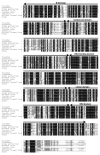Molecular cloning and expression analysis of the STAT1 gene from olive flounder, Paralichthys olivaceus
- PMID: 18578892
- PMCID: PMC2443792
- DOI: 10.1186/1471-2172-9-31
Molecular cloning and expression analysis of the STAT1 gene from olive flounder, Paralichthys olivaceus
Abstract
Background: Signal transducer and activator of transcription 1 (STAT1) is a critical component of interferon (IFN)-alpha/beta and IFN-gamma signaling. Although seven isoforms of STAT proteins have been reported from mammals, limited information is available for the STAT genes in fish. We isolated complementary DNA with high similarity to mammalian STAT1 from the olive flounder, Paralichthys olivaceus.
Results: A DNA fragment containing the conserved SH2 domain was amplified by RT-PCR using degenerate primers designed based on the highly conserved sequences in the SH2 domains of the zebrafish and mammalian STAT1. The complete cDNA sequence was obtained by 5' and 3' RACE. The flounder STAT1 transcript consisted of 2,909 bp that encoded a polypeptide of 749 amino acids. The overall similarity between flounder STAT1 and other STATs was very high, with the highest amino acid sequence identity to snakehead (89%). Phylogenetic analyses reveal that flounder STAT1 is in the same monophyletic group with snakehead STAT1. Quantitative real time RT-PCR and in situ hybridization revealed that STAT1 was expressed in almost all examined organs and tissues, with high expression in gill, spleen, kidney, and heart. The accumulation of STAT1 mRNA in different developmental stages, as determined by real time RT-PCR, increased with development.
Conclusion: Recent cloning of various cytokine genes and the STAT1 gene of olive flounder here suggest that fish also use the highly specialized JAK-STAT pathway for cytokine signaling. Identification of other STAT genes will elucidate in detail the signal transduction system in this fish.
Figures






Similar articles
-
Interferon regulatory factor 3 (IRF-3) in Japanese flounder, Paralichthys olivaceus: sequencing, limited tissue distribution, inducible expression and induction of fish type I interferon promoter.Dev Comp Immunol. 2011 Feb;35(2):164-73. doi: 10.1016/j.dci.2010.09.003. Epub 2010 Sep 21. Dev Comp Immunol. 2011. PMID: 20837055
-
Cloning and expression analysis of cathepsin D in the olive flounder Paralichthys olivaceus.Biosci Biotechnol Biochem. 2009 Aug;73(8):1856-9. doi: 10.1271/bbb.80822. Epub 2009 Aug 7. Biosci Biotechnol Biochem. 2009. PMID: 19661707
-
Molecular cloning and mRNA expression of the liver-specific cathepsin L1 gene of the olive flounder, Paralichthys olivaceus.Biosci Biotechnol Biochem. 2011;75(6):1214-8. doi: 10.1271/bbb.110220. Epub 2011 Jun 13. Biosci Biotechnol Biochem. 2011. PMID: 21670505
-
Molecular cloning and expression analysis of interferon regulatory factor 10 (IRF10) in Japanese flounder, Paralichthys olivaceus.Fish Shellfish Immunol. 2011 Jan;30(1):67-76. doi: 10.1016/j.fsi.2010.09.010. Epub 2010 Sep 29. Fish Shellfish Immunol. 2011. PMID: 20883793
-
Molecular cloning and characterization of interferon regulatory factor 7 (IRF-7) in Japanese flounder, Paralichthys olivaceus.Fish Shellfish Immunol. 2010 Dec;29(6):963-71. doi: 10.1016/j.fsi.2010.08.002. Epub 2010 Aug 14. Fish Shellfish Immunol. 2010. PMID: 20713159
Cited by
-
Structural and Functional Analyses of Type I IFNa Shed Light Into Its Interaction With Multiple Receptors in Fish.Front Immunol. 2022 Mar 22;13:862764. doi: 10.3389/fimmu.2022.862764. eCollection 2022. Front Immunol. 2022. PMID: 35392096 Free PMC article.
-
Structural and functional studies of STAT1 from Atlantic salmon (Salmo salar).BMC Immunol. 2010 Mar 30;11:17. doi: 10.1186/1471-2172-11-17. BMC Immunol. 2010. PMID: 20353564 Free PMC article.
-
Molecular cloning and expression analysis of the STAT1 gene in the water buffalo (Bubalus bubalis).Trop Anim Health Prod. 2015 Jan;47(1):53-9. doi: 10.1007/s11250-014-0682-6. Epub 2014 Oct 22. Trop Anim Health Prod. 2015. PMID: 25336386
-
Functional analysis of Rousettus aegyptiacus "signal transducer and activator of transcription 1" (STAT1).Dev Comp Immunol. 2010 May;34(5):598-602. doi: 10.1016/j.dci.2010.01.004. Epub 2010 Jan 15. Dev Comp Immunol. 2010. PMID: 20067804 Free PMC article.
-
Screening and analysis of PoAkirin1 and two related genes in response to immunological stimulants in the Japanese flounder (Paralichthys olivaceus).BMC Mol Biol. 2013 May 7;14:10. doi: 10.1186/1471-2199-14-10. BMC Mol Biol. 2013. PMID: 23651673 Free PMC article.
References
-
- Wesoly J, Szweykowska-Kulinska Z, Bluyssen HA. STAT activation and differential complex formation dictate selectivity of interferon responses. Acta Biochim Pol. 2007;54:27–38. - PubMed
Publication types
MeSH terms
Substances
LinkOut - more resources
Full Text Sources
Molecular Biology Databases
Research Materials
Miscellaneous

